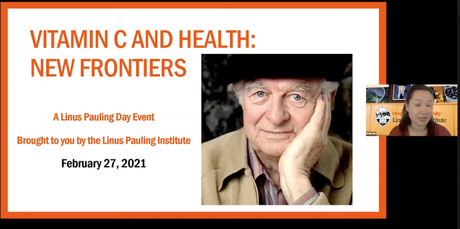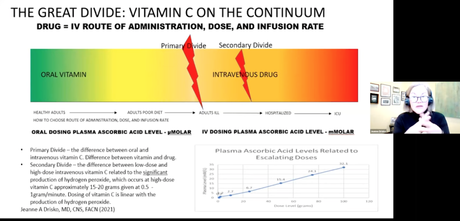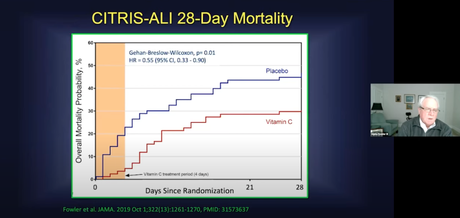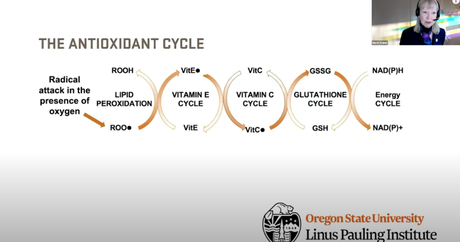
[Part 1 of 2]
On February 27, 2021, the Linus Pauling Institute (LPI) at Oregon State University hosted its annual Linus Pauling Day celebration, using the occasion to also mark twenty-five years of LPI at OSU. The eponymous celebration is traditionally held on Pauling’s birthday, who on February 28, 2021 would have been 120 years old. The event this year, held a day early, was also conducted entirely over Zoom due to the COVID-19 pandemic. Because it was held in a virtual space, the event was able to attract a large audience, with moderator Alexander Michels – a research associate at LPI – noting that over 1,200 people were in attendance.
This year’s topic, “Vitamin C and Health: New Frontiers” focused on the latest research into vitamin C and its impact on human health. Four experts – Anitra Carr Ph.D., University of Otago; Alpha “Berry” Fowler III M.D., Virginia Commonwealth University; Jeanne Drisko M.D., University of Kansas; and Maret Traber Ph.D., OSU – spoke about recent trends in basic and clinical research, covering topics including cancer, sepsis, and COVID-19. The 90-minute event began with prepared comments from the speakers followed by a question-and-answer session moderated by Michels.

LPI director Emily Ho opened the event by providing some useful background on Pauling and his contributions to vitamin C research. As Ho explained, Pauling was “a true innovator” whose research into vitamin C was not initially embraced by the scientific community, despite clear evidence of its efficacy in helping reduce infection and prevent disease. Ho also explained how Pauling viewed vitamin C as the perfect vehicle to explore ideas on orthomolecular medicine; the notion that, through the intake of “the right molecule at the right dose,” one might prevent or cure many ailments. In this, Pauling helped to “revolutionize” the connection between vitamins and health.

Following Ho’s introduction, the day’s first speaker, Anitra Carr from the University of Otago in New Zealand, began her prepared remarks. Carr has a long history of working with vitamin C. Before beginning her current position in her university’s Nutrition in Medicine Research Group, Carr worked as a researcher at LPI. In 2001, Carr’s collaboration with former LPI Director Balz Frei on vitamin C and its connection to cardiovascular health helped bring about a change in the Recommended Dietary Allowance from 60mg to the 90mg per day for healthy adults.
In her talk, Carr presented an overview of vitamin C and its relationship to fighting disease. Carr explained that most animals synthesize their own vitamin C and therefore do not require any external sources of the vitamin. But humans, along with a few other animals, lack the enzyme needed to produce their own vitamin C. As vitamin C is required by humans to sustain life – it is essential for cellular energy production, hormone and neurotransmitter synthesis, metabolic regulation and, as recently determined, gene regulation – it must be obtained entirely through the consumption of fruits and vegetables, or from supplements.
Carr also reminded audience members of Pauling’s critical role in establishing vitamin C as a viable molecule to combat disease. In the 1970s, Pauling, along with Scottish surgeon Ewan Cameron, found that intravenous vitamin C megadosing could drastically improve the prognosis for critically ill cancer patients, if not outright cure them. But this research was overshadowed by other trials conducted by the Mayo Clinic that found no changes in survival rate between a placebo group and trial group. In reviewing this history, Carr stressed that the Mayo Clinic’s trial administered vitamin C orally, not intravenously, and this difference has since been proven to be quite significant. Recent research has found that intravenous vitamin C “bypasses the regulated intestinal uptake,” meaning that a person “can get much higher levels of vitamin C” in their system when the dosing is applied intravenously. In addition to improved absorption, the intravenous approach also allows for much higher doses to be applied: present-day IV infusion bags for cancer patients contain about 70 g of vitamin C, which is equivalent to about 1,000 oranges.
From there, Carr moved on to recent vitamin C research including her own, which explores the relationship between vitamin C and colorectal cancers. Specifically, Carr and her team have biopsied colorectal tumors and found that, at their core, they contain very low levels of vitamin C. When these same patients have been dosed with intravenous vitamin C, their tumor cores show higher levels of the vitamin. This finding connects with other work suggesting that, when cancer patients have high levels of vitamin C in their tumors, their prognosis improves. This is so because “vitamin C helps white blood cells eliminate pathogens from the body.” Likewise, people who are sick often have higher blood plasma levels of vitamin C, an indication of their need for the vitamin, since any unused vitamin C is rapidly excreted throughout the body. By extension, “critically ill patients tend to have higher requirements for vitamin C.”

The next speaker was Jeanne Drisko, who spoke further on the effects that vitamin C can have on prognosis. An emeritus professor at the University of Kansas Medical Center, Drisko’s presentation focused intently on the differences between oral and intravenous vitamin C (IVC), and how these two routes of administration make big differences in the ways that vitamin C acts on the body.
As Drisko explained, for healthy people, obtaining vitamin C orally (either through diet or supplements) is usually enough to maintain proper levels. (In Drisko’s slide above, this status is indicated in green.) However, when people become sick, oral vitamin C dosing is no longer adequate. This circumstance is what Drisko calls the “primary divide” and can be seen in her chart as a progression into the redder colors. Once an individual has crossed over the primary divide, their vitamin C needs increase by orders of magnitude, from requirements in the micromolar range to requirements in the millimolar range. A jump of this sort is akin to leaping across the Grand Canyon, and not achievable through the intake of oral vitamin C. Because of the inhibitory transport molecules in the gut, oral vitamin C cannot provide the blood with millimolar levels of vitamin C, and is therefore inadequate for people who have arrived at that level of need.
In the context of IVC however, differences emerge in the way that vitamin C acts within the body, depending on the dose. In the millimolar range of IVC, vitamin C can be considered a “prodrug.” In using this type of instance, Drisko explained that vitamin C is not the actor that is creating positive health benefits, but instead is acting upon a substance that is creating the positive effects. Specifically, vitamin C (“the prodrug”) helps promote the curative powers of hydrogen peroxide (“the drug”). Vitamin C saturation can eventually reach a point where it acts as a drug, and at those levels, one crosses into the “secondary divide” where the full benefits of vitamin C can be seen. Patients can arrive at the “secondary divide” with IVC dosing of about 10 grams or more, “even up to 100 grams.” Depending on the circumstances, one can benefit from increasing up to such large doses because, as Drisko put it, “it’s a linear response; the higher the dose of IVC the higher the production of hydrogen peroxide.”
Because different metabolic changes occur depending on levels of vitamin C saturation, Drisko noted that proper dosing is a critical component of any successful IVC protocol. Drisko likened this to a scenario where a prescriber treats a MRSA patient with vancomycin, an antibiotic known to be effective with bacterial infections. The proper dose to treat MRSA is one gram every eight hours, but in the hypothetical, this doctor gives the patient just one milligram every eight hours. A prescription of this sort would necessarily mean that the patient is underdosed and will not have adequate blood levels of the antibiotic to fight MRSA. As Drisko pointed out, this scenario doesn’t mean that the vancomycin is ineffective, it just means that the wrong dose was given. As with vitamin C, “dose is critical.”
So too is the rate at which a dose is administered. From her research, Drisko has concluded that an infusion rate of 0.5-1 gram per minute – akin to about 50 grams every 1-2 hours – is ideal. And while Drisko assured her audience that these high doses are safe, there is a caveat: those with a G6PD deficiency and/or a propensity for developing oxalate kidney stones should not undergo IVC therapy because of potentially life-threatening complications. (These risk factors will be discussed in more detail in our next post).

The next presentation was delivered by Alpha “Berry” Fowler III, who spoke about the connection between vitamin C, sepsis, and COVID-19. Fowler, a professor of Medicine at Virginia Commonwealth University, has found that when people are in sepsis, their vitamin C blood plasma levels drop to alarmingly low levels that nearly approximate those found in sufferers of scurvy. This led Fowler to conclude that illness and vitamin C are linked, and that those who are critically ill are somehow using up their vitamin C at a much more rapid rate than those who are not.
Seeking to test the theory that vitamin C plays a role in disease management, Fowler received funding from the National Institutes of Health to conduct a Phase III trial titled “Vitamin C Infusion for Treatment in Sepsis-Induced Acute Lung Injury.” Fowler specifically chose to test those with lung-related sepsis due to the prevailing connection between lung disease and low vitamin C levels.
In his study, which was deployed at seven medical centers around the U.S., 170 participants were randomized, with 83 placed on a placebo and 84 enrolled in the trial. Both groups received the same standard of care for sepsis, including the use of ventilators as needed. The only difference in care was that the trial group received an infusion of vitamin C at a rate of 50mg/kg every six hours over a 96-hour period, an approach that was subsequently named the “VCU Protocol.” The research team found that those receiving vitamin C infusions had plasma levels rise from the micromolar to the millimolar level – a 6,000-fold increase. Fowler and his team then charted incidents of organ failure and death over the next five years. During this period of time, 46% of the placebo patients died, as compared to 30% of the vitamin C patients.
Buoyed by these results, Fowler is now working on expanding the initial trial to a larger scale. He is also currently involved with a study on vitamin C treatment of COVID-19 pneumonia, with 140 patients currently enrolled and using the VCU Protocol.

The last speaker of the day was Maret Traber, a nutritionist and the Ava Helen Pauling Chair at LPI. Traber’s topic was Metabolic Syndrome (METS), a designator used for a range of people who are on the verge of developing disease, including obese or pre-diabetic individuals. In the U.S., approximately 35% of adults have METS. As Traber noted, people with METS also tend to have chronically low levels of vitamin C, though why this is the case is still an open question. The good new though, is that even if people have METS, they can get satisfactory levels of vitamin C through diet alone, and don’t need to be treated with IVC. Traber recommends 5-9 servings of fruits and vegetables per day for healthy people and people with METS alike. Eating a diet of this sort will also supply adequate levels of other vitamins including vitamin E – the primary focus of Traber’s work – which can work synergistically with vitamin C to reduce free radicals in the body.
After the panelists gave their talks, the forum was opened up to a question-and-answer session. This portion of the event will be covered in next week’s post.
